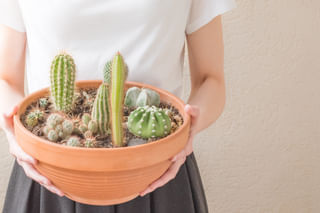Watering techniques for Cacti
Looking to keep your cacti thriving? This guide breaks down everything you need to know about watering and caring for these unique plants, including tips for epiphytic varieties and how to choose the right growing medium. Say goodbye to cactus care confusion and hello to happy, healthy greenery!

Cacti love the drought, but even the most drought-loving plants need to be watered every once in a while. So how do you water a cactus? And is it any different from watering a "normal" houseplant?
Let's find out!
Watering techniques for all cacti
When it comes to watering cacti, different species have their own needs depending on where they come from and how they grow. Knowing these differences is key to making sure each type of cactus thrives under your care.
In this section, we'll look at specific watering tips for various cactus types to help you take the best care of your plants.
- Deep watering: Water your cactus thoroughly until water drains out of the bottom of the pot. This ensures the roots receive adequate moisture.
- Drainage: Always use a pot with drainage holes and well-draining soil to prevent waterlogging and root rot.
- Seasonal changes: Adjust watering frequency according to the season. Water more frequently during the growing season (spring and summer) and reduce watering during the dormant period (fall and winter).
Specific techniques for different types of cacti
We've seen the watering techniques that are the same for all cacti in the previous section, so let's dive a little deeper and look at some specific types of cacti. The different types of cacti have slightly different water needs.
Desert Cacti (E.g., Saguaro, Barrel Cactus)
When it comes to watering your desert cacti, aim for every 2 to 4 weeks during the growing season. Just make sure to let the soil dry out completely before giving them another drink! In the winter, though, you can ease up on the watering schedule. These tough little plants can actually go for months without any water when they're dormant, so a little sparing watering or even skipping it altogether is totally fine.
Tropical Cacti (E.g., Christmas Cactus, Easter Cactus)

Unlike the desert cacti, your tropical cacti are happiest when you keep the soil a bit moist during the growing season, so water them when the top inch feels dry. Also, these plants enjoy a bit of humidity, so don't hesitate to mist them occasionally for a nice boost.
As for the dormant period, just remember to cut back on watering a bit, but don't let the soil dry out completely. A little sprinkle here and there will keep them content!
Epiphytic Cacti (E.g., Orchid Cactus)
An epiphytic cactus is a cactus that grows on other plants for physical support. These types of cacti generally grow in tropical and subtropical forests. These plants don't get their moisture from soil, but from the air and the plant they're going on.
When it comes to caring for these cacti, watering them regularly during the growing season is key. You want to keep the growing medium consistently moist.
Since these plants don't really grow in soil, you'll want to use something like Orchid bark as a growing medium. You can also use any other well-draining, airy mix that's great for epiphytic plants. And during their dormant period, cut back on the watering a bit, but make sure there's still a little moisture in the soil to keep them happy.
Tips for watering a cactus
When it comes to watering your cactus, stick with room-temperature water and try not to splash the cactus itself-nobody wants a rotting plant! It's a good idea to check the soil moisture before giving it a drink. You can do this easily with your finger or a moisture meter.
Also, keep in mind the environmental factors around your cactus. Things like humidity, temperature, and light can all affect how often you should water. So, pay attention to those conditions and adjust your watering schedule accordingly to keep your cactus happy!
For more information about taking care of cacti, I recommend you read How to take care of an indoor cactus next.
Thank you for reading this post! I hope it helps you to keep your plants healthy and beautiful! If you're looking for more guides on specific plants, you can always request a plant guide to get a guide for the plant you have trouble with.
Test your plant care knowledge
Quiz completed!
Want to learn more? Sign up for my newsletter to receive free tips in your inbox!
Sign up now!










